Living with Hearing Loss
Effective Deaf Dog Trainer Techniques
Keen insight into the world of deaf dog training unveils the intricate dance of communication and trust – discover the art of silent connection that transcends words.
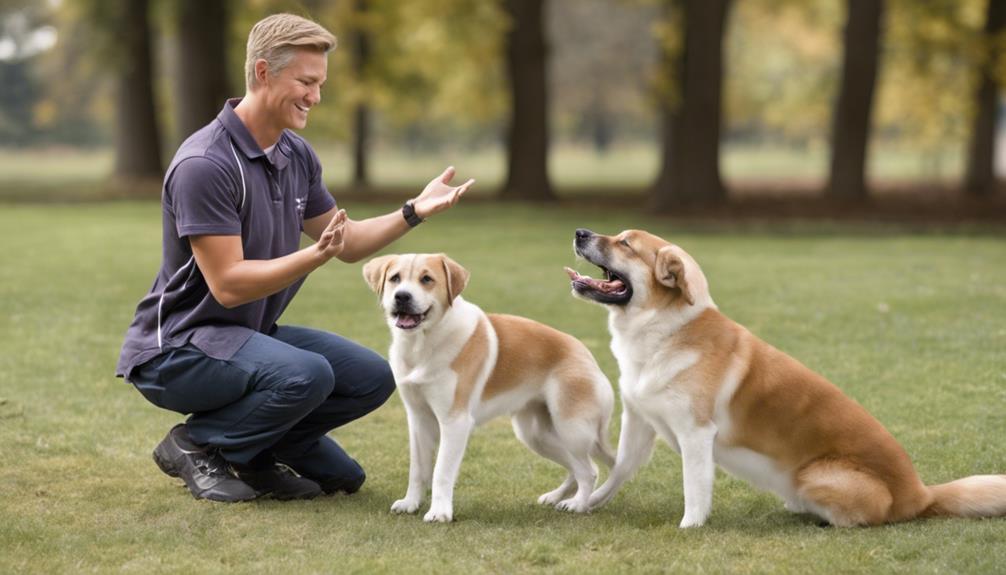
In the world of training deaf dogs, hand signals are like the keys that unlock a hidden language between us and our furry companions.
But what truly makes a trainer effective in this unique realm goes beyond just gestures; it delves into the art of building trust, understanding behavior, and mastering the intricacies of visual communication.
Let's explore the nuances and expertise required to navigate this silent yet profound journey with our deaf canine friends.
Key Takeaways
- Utilize visual cues and hand signals for clear communication and training success.
- Build trust through consistency, patience, and positive reinforcement techniques.
- Incorporate clicker training and consistent schedules for effective behavior shaping.
- Provide enrichment through socialization, varied environments, and mental stimulation activities.
Understanding Deaf Dog Behavior
Understanding deaf dog behavior requires a keen awareness of their reliance on visual and tactile cues for communication and learning. Training deaf dogs involves adapting traditional methods to focus on visual cues and positive reinforcement.
Since they can't rely on verbal commands, trainers utilize hand signals and body language to communicate effectively. This shift in training methods emphasizes the importance of clear and consistent visual cues.
Deaf dogs excel in environments where visual signals are prominent, making training sessions more efficient when utilizing gestures and signals. Incorporating visual cues into obedience training helps deaf dogs understand expectations and commands.
Importance of Visual Communication

Visual communication plays a pivotal role in the successful training and interaction with deaf dogs due to their reliance on non-verbal cues. Deaf dogs heavily depend on visual signals, such as hand gestures, to understand commands and information effectively. Clear and consistent visual cues are essential for deaf dogs to grasp training instructions and respond appropriately. By utilizing visual communication, trainers can bridge the communication gap caused by deafness in dogs, leading to improved training outcomes and a stronger bond between the trainer and the dog.
Since deaf dogs can't rely on auditory cues, visual communication becomes the primary mode of conveying information and building trust. The use of visual cues not only aids in training but also enhances the overall relationship between the trainer and the deaf dog. Through innovative approaches that emphasize visual signals, trainers can establish a clear means of communication that's tailored to the unique needs of deaf dogs, facilitating successful training sessions and fostering a deeper connection.
Establishing Trust and Connection
Establishing trust and connection with a deaf dog involves consistent positive interactions that utilize visual cues for effective communication. Training deaf dogs requires special attention to visual cues, as they rely on these signals to understand commands and behaviors. By incorporating visual cues into training sessions, trainers can bridge the communication gap and build a strong foundation of trust with their deaf canine companions.
Understanding the unique needs of deaf dogs is crucial in forming a deep connection. Patience, observation of body language, and respect for boundaries are key components in earning a deaf dog's trust. Routine and predictability play a significant role in creating a secure bond with these animals, as it helps them feel safe and supported during training.
Utilizing touch cues and rewards can further enhance the bond between a deaf dog and their trainer. These positive reinforcements not only strengthen trust but also motivate the dog to actively participate in training exercises. Ultimately, establishing trust and connection is fundamental for successful training outcomes and fostering a harmonious relationship between the deaf dog and their trainer.
Hand Signals for Training Success
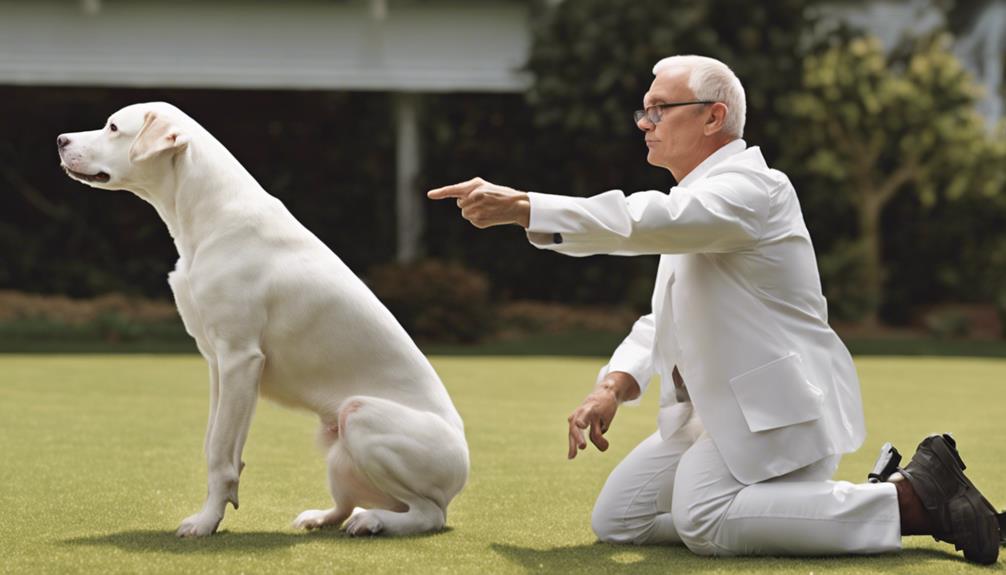
Hand signals serve as the cornerstone of successful training for deaf dogs, offering a reliable means of communication that fosters understanding and responsiveness to commands and cues. When utilizing hand signals in training techniques, it's crucial to ensure they're consistent, clear, and easily distinguishable. Deaf dogs rely on visual cues to comprehend instructions, making the clarity of hand signals paramount for effective communication. By incorporating precise hand signals into training sessions, trainers can promote focus, engagement, and successful learning outcomes for their deaf canine companions.
Consistency in using hand signals helps deaf dogs understand and respond to various commands and cues with accuracy. This consistency reinforces positive behaviors and strengthens the bond between the trainer and the deaf dog. Clear and distinct hand signals not only facilitate communication but also reduce confusion during training sessions, leading to more efficient learning experiences. When executed properly, hand signals can significantly enhance the training process for deaf dogs, paving the way for improved obedience and heightened interaction between trainer and pet.
Positive Reinforcement Techniques
Utilizing positive reinforcement techniques is a proven method for effectively shaping desired behaviors in deaf dogs through the strategic use of rewards. Positive reinforcement involves rewarding deaf dogs with treats or toys when they exhibit desirable behaviors, encouraging them to repeat those actions. Incorporating a clicker to mark good behaviors can further reinforce positive actions in training a deaf dog. Consistency in training schedules is paramount to promote learning and progress in deaf dogs, as they rely heavily on routine. It is essential to avoid punitive training methods and instead focus on patience and positive reinforcement to achieve successful training outcomes with deaf dogs. By using positive reinforcement techniques, a strong bond can be built between the trainer and the deaf dog, enhancing communication and trust.
| Rewards | Benefits |
|---|---|
| Treats or toys | Encourages repetition of desired behaviors |
| Clicker | Reinforces positive actions effectively |
| Consistent schedule | Promotes learning and progress in deaf dogs |
| Patience | Key to successful training outcomes |
| Bond building | Enhances communication and trust between trainer and deaf dog |
Addressing Behavioral Challenges

How can behavioral challenges in deaf dogs be effectively addressed? Deaf dogs may face issues such as separation anxiety, communication barriers, and socialization difficulties. When tackling these challenges, training techniques specific to deaf dogs are essential. Utilizing positive reinforcement, establishing consistent routines, and employing clear communication methods are key strategies. To address fear-based behaviors, patience, desensitization, and trust-building exercises through positive interactions are crucial.
Understanding the root causes of behavioral challenges is fundamental for deaf dog trainers. By tailoring training methods to each dog's specific needs, trainers can effectively address and modify unwanted behaviors. Seeking professional guidance and support can also be beneficial in creating personalized strategies to tackle behavioral issues in deaf dogs.
Innovative approaches that combine traditional training methods with specialized techniques for deaf dogs can yield positive results. By focusing on empathy, creativity, and a deep understanding of canine behavior, trainers can navigate and overcome the behavioral challenges faced by deaf dogs effectively.
Building Confidence in Deaf Dogs
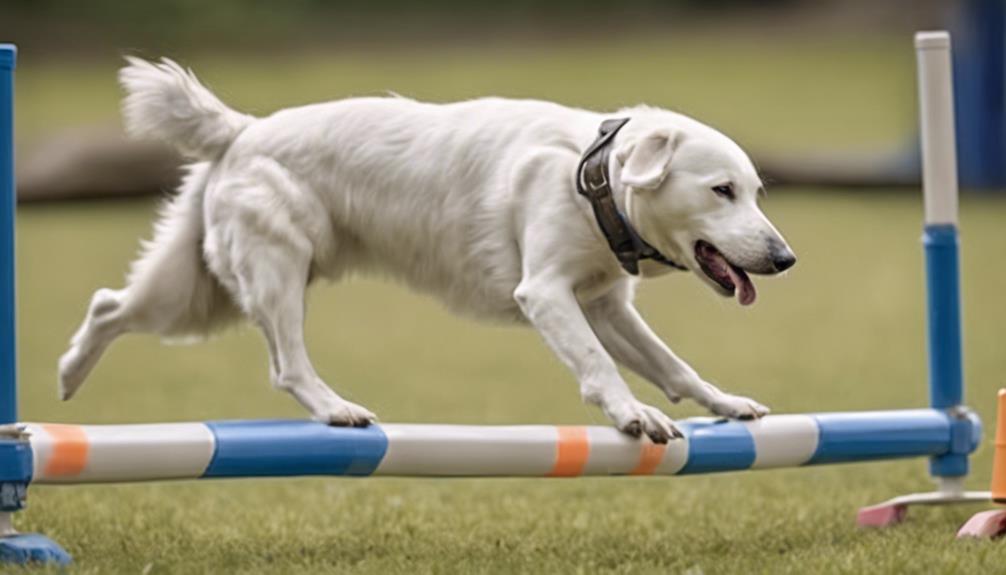
To enhance the well-being and behavior of deaf dogs, fostering confidence through positive reinforcement techniques is paramount. Building confidence in deaf dogs involves creating a positive and supportive environment where desired behaviors are encouraged and rewarded. Positive reinforcement, such as treats, toys, or praise, can help deaf dogs associate good behavior with positive outcomes, boosting their self-assurance.
Providing a safe and secure space for deaf dogs is crucial in helping them feel more confident and less anxious. Gradual exposure to new experiences and environments can also play a significant role in building a deaf dog's confidence over time. Consistent training routines and clear communication methods are essential in enhancing a deaf dog's self-assurance. Celebrating small victories and progress with rewards can further increase a deaf dog's confidence levels, reinforcing positive behaviors and strengthening the bond between the dog and its trainer.
Effective Recall Strategies

When training deaf dogs for effective recall, consistency in using hand signals or visual cues is key to reinforcing positive behavior. Deaf dogs rely on these cues to understand commands, making them crucial in recall training.
Incorporating high-value rewards or treats further strengthens the desired behavior. By associating the hand signal with a rewarding outcome, deaf dogs are motivated to respond promptly when called.
It's essential to practice recall training in various environments to generalize the behavior, ensuring that the dog can recall reliably regardless of the setting. Starting in a low-distraction environment and gradually increasing distractions helps build a strong foundation for recall.
Additionally, fostering a strong bond with your deaf dog enhances the effectiveness of recall training, as trust and communication are fundamental in this process. Consistent use of hand signals and positive reinforcement sets the stage for successful recall training in deaf dogs.
Socialization Strategies for Deaf Dogs
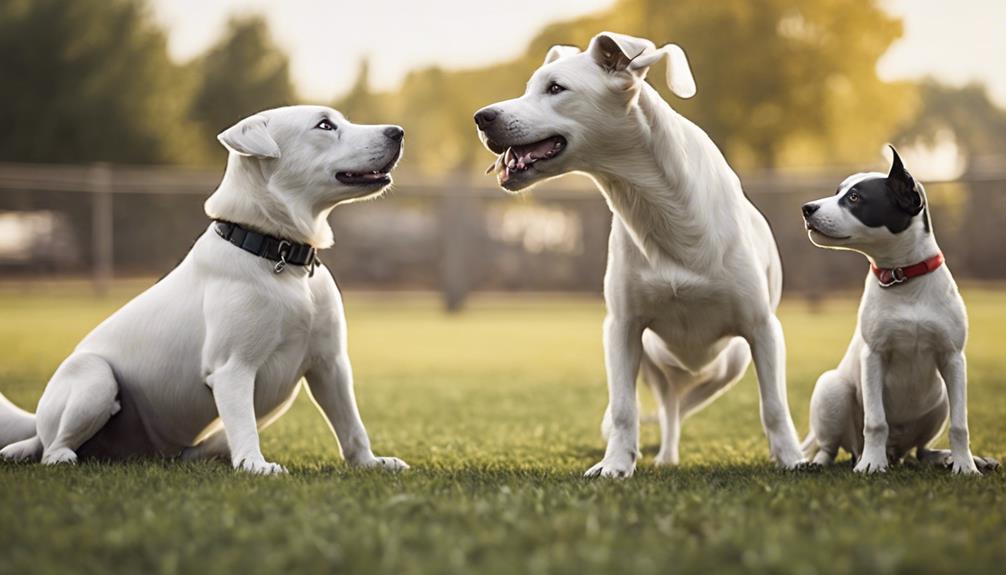
Socialization plays a vital role in helping deaf dogs acclimate to different environments and interact confidently with others. By utilizing canine playgroups, visual cues for training, and exposure to a variety of environments, we can create positive experiences that build their social skills.
This approach, coupled with positive reinforcement, can help deaf dogs develop into well-adjusted companions capable of navigating various social situations with ease.
Canine Playgroups for Socialization
Canine playgroups play a vital role in fostering socialization skills and positive interactions for deaf dogs. These groups offer a safe environment for deaf dogs to interact with others, enhancing their ability to understand appropriate behaviors and body language cues.
By engaging with a diverse range of dogs, deaf dogs can build confidence and improve their communication skills. The structured setting of playgroups allows deaf dogs to practice social skills and form positive relationships with their canine counterparts.
Proper supervision in these settings not only promotes mental stimulation but also provides essential physical exercise, contributing to the overall well-being of deaf dogs. Participating in playgroups can significantly benefit deaf dogs by improving their socialization and overall quality of life.
Visual Cues for Training
Utilizing visual cues is paramount in effectively training deaf dogs, given their reliance on sight for communication. When training a deaf dog, incorporating visual cues can significantly enhance the learning process. Here are three key strategies to train a deaf dog using visual cues:
- Consistent hand gestures: Using consistent hand signals for commands helps deaf dogs understand and respond appropriately.
- Visual tools: Tools like flashlights or vibrating collars can aid in signaling commands over longer distances, improving communication during training sessions.
- Adequate lighting: Good lighting conditions are crucial for clear visibility when using visual cues with deaf dogs, ensuring effective communication and understanding.
Exposure to Different Environments
Exposing deaf dogs to a variety of environments plays a crucial role in their socialization and overall development. Socialization strategies for deaf dogs should encompass exposure to diverse settings, people, and animals early on. Introducing them to various sounds, textures, and experiences aids in their adaptability and confidence. Positive interactions in different environments help deaf dogs in developing social skills and reducing anxiety. Controlled introductions to new stimuli are essential to prevent fear or aggression responses during socialization. Monitoring the deaf dog's comfort levels during gradual exposure to different environments is key for successful socialization.
| Strategies for Exposure to Different Environments | |
|---|---|
| Early introduction to diverse settings | Introducing various sounds, textures, experiences |
| Positive interactions in different environments | Controlled introductions to new stimuli |
| Monitoring comfort levels during exposure |
Agility Training for Deaf Dogs
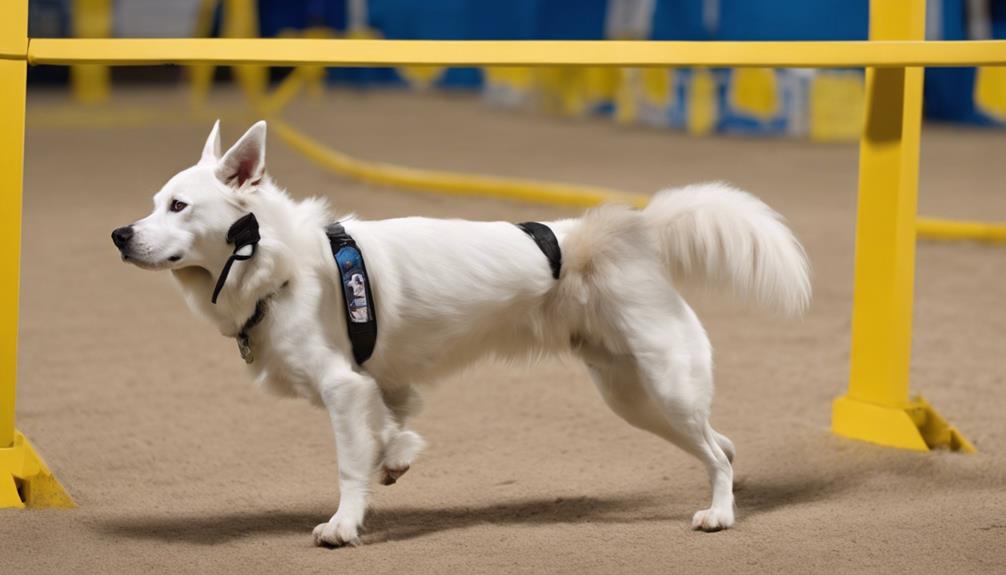
When training deaf dogs in agility, adapting courses with visual cues and tactile signals is essential for effective navigation through obstacles. Using treats as rewards for completing tasks can also be a useful method to motivate and communicate with deaf dogs during agility training sessions.
- Incorporate hand signals and gestures: Utilize clear hand signals and gestures to guide the deaf dog through the agility course.
- Implement ground vibrations: Establish specific ground vibrations to signal different actions or directions to the deaf dog.
- Use light cues: Integrate light cues strategically placed throughout the course to direct the deaf dog's movements accurately.
These innovative techniques enhance the training experience for deaf dogs, allowing them to participate fully in agility courses. By focusing on visual and tactile communication methods, trainers can help deaf dogs excel in agility training, showcasing their intelligence and agility in a unique and enriching way.
Enrichment Activities for Deaf Dogs
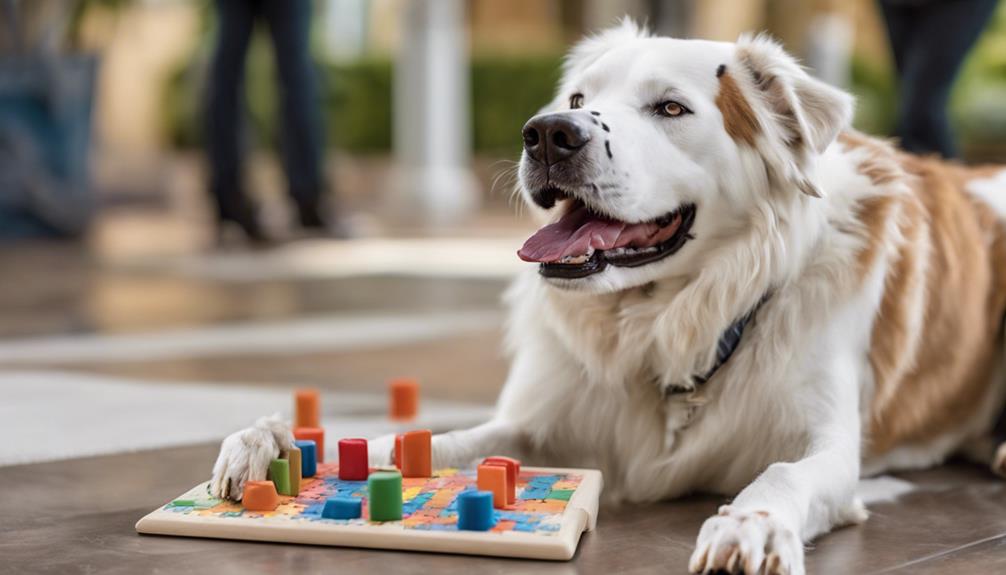
When it comes to enriching the lives of deaf dogs, sensory stimulation games and visual cue training are essential components.
These activities not only provide mental engagement but also help deaf dogs navigate their world effectively.
Incorporating such enrichment activities can lead to a happier and more fulfilled life for our furry companions.
Sensory Stimulation Games
Engaging a deaf dog in sensory stimulation games is a beneficial way to enhance their mental acuity and prevent boredom while promoting their overall well-being. These activities focus on engaging their other senses like smell, touch, and sight, providing mental enrichment beyond auditory stimuli.
Some examples of sensory stimulation games for deaf dogs include:
- Scent work: Engaging the dog's sense of smell through activities like hiding treats or toys for them to find.
- Puzzle toys: Toys that require the dog to solve a puzzle to access a treat, stimulating their problem-solving skills.
- Tactile games: Activities that involve textures and touch, such as different surfaces for the dog to explore with their paws or nose.
Visual Cue Training
Visual cue training is an essential component of enrichment activities for deaf dogs, stimulating their cognitive abilities through the use of non-auditory signals. Deaf dogs rely heavily on visual cues like hand signals or light signals to communicate, making it crucial to incorporate these cues into their training routines.
By engaging a deaf dog's attention through visual cues, trainers can effectively teach new commands and behaviors. Furthermore, the consistent use of visual cues in enrichment activities not only enhances the bond between the owner and the deaf dog but also provides mental stimulation that prevents boredom.
Interactive games that incorporate visual cues offer a fun and engaging way to reinforce desired behaviors, ultimately contributing to the overall well-being of deaf dogs.
Addressing Separation Anxiety

Deaf dog trainers employ specialized techniques to effectively address separation anxiety in their canine companions, focusing on building independence and confidence. Deaf dogs, relying heavily on visual and tactile cues for communication, are more prone to separation anxiety, which can lead to destructive behaviors and self-harm.
To help deaf dogs overcome separation anxiety, trainers implement innovative methods such as:
- Providing interactive toys: Engaging toys can help distract deaf dogs and keep them mentally stimulated while their owners are away.
- Creating a safe space: Establishing a designated area within the home where the dog feels secure and comfortable can reduce anxiety during separations.
- Gradual desensitization: Slowly exposing the deaf dog to short periods of alone time and gradually increasing the duration can help build their confidence and independence.
Training for Good Leash Manners
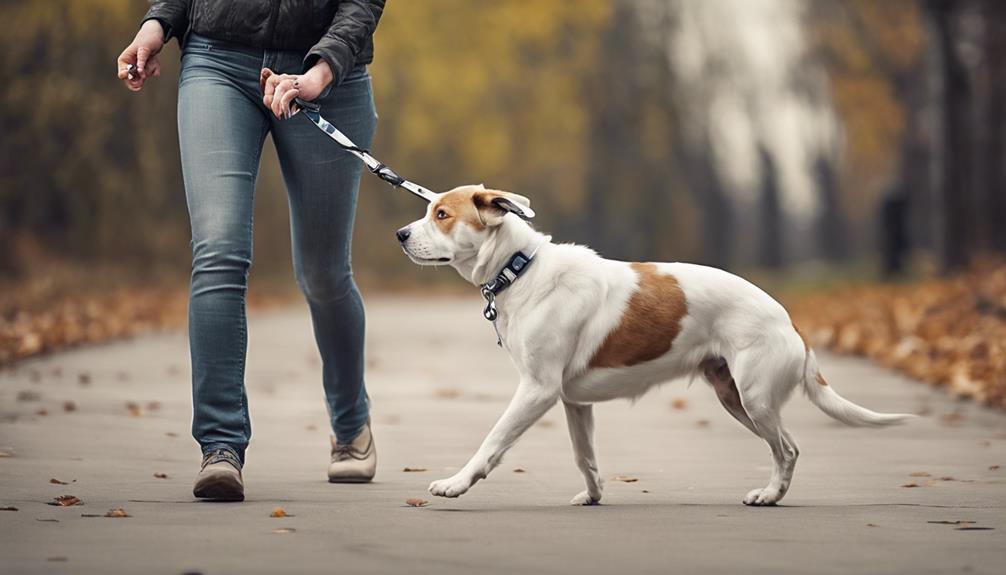
When training for good leash manners in deaf dogs, it's essential to focus on leash handling techniques, positive reinforcement methods, and a consistent practice regimen.
Visual cues and hand signals can effectively convey expectations to the dog during walks.
Leash Handling Techniques
Proper leash handling techniques play a crucial role in instilling good leash manners in dogs, particularly those who are deaf. When working with deaf dogs, visual cues become paramount for effective communication during walks.
Here are some key techniques to consider:
- Use a sturdy, comfortable leash to maintain control and facilitate communication with your deaf dog.
- Avoid jerking or pulling on the leash to prevent unsettling and confusing experiences for your deaf dog.
- Practice loose leash walking to encourage your deaf dog to stay beside you without experiencing tension on the leash.
Positive Reinforcement Methods
Utilizing positive reinforcement methods is a highly effective approach for training deaf dogs to exhibit good leash manners during walks. Rewarding a deaf dog with treats or toys when they display desired leash behaviors reinforces the calm walking conduct.
Consistency in rewarding these behaviors helps deaf dogs understand what's expected of them and encourages them to repeat the actions. Clicker training can also be beneficial in marking the precise moment the dog demonstrates good leash manners.
Consistent Practice Regimen
Consistent practice plays a crucial role in shaping a deaf dog's leash manners, laying the foundation for effective leash training. Regular training sessions are essential for reinforcing desired behaviors on the leash.
By repeating leash training exercises, a strong foundation for walking can be built, ensuring that the deaf dog understands proper leash etiquette. Consistency in training methods is key to helping the dog learn and maintain good leash manners.
Gradual progression in the training program is also important as it allows the deaf dog to learn to walk politely on a leash, ultimately leading to successful leash manners.
Teaching Watch Me Cue

To effectively teach the 'Watch Me' cue to a deaf dog, establish a clear visual signal or hand gesture for capturing their attention. Using consistent teaching hand signals or visual cues helps in communicating effectively with your deaf dog. Here is a table illustrating some common hand gestures used for the 'Watch Me' cue:
| Hand Gesture | Description | Usage |
|---|---|---|
| Pointing Finger | Point towards your eyes | Direct your dog's attention to you |
| Open Palm | Show your open palm facing your dog | Signal your dog to focus on you |
| Tap on Shoulder | Gently tap your shoulder where your dog can see | Prompt your dog to look at you |
| Two Fingers to Eyes | Place two fingers on your eyes | Encourage eye contact with your dog |
| Waving Hand | Wave your hand in front of your face | Attract your dog's attention to you |
Reward your deaf dog for responding to these visual cues with eye contact, reinforcing the behavior positively. Practice these signals consistently in different environments to improve your dog's responsiveness and understanding of the 'Watch Me' cue.
Advanced Training Techniques
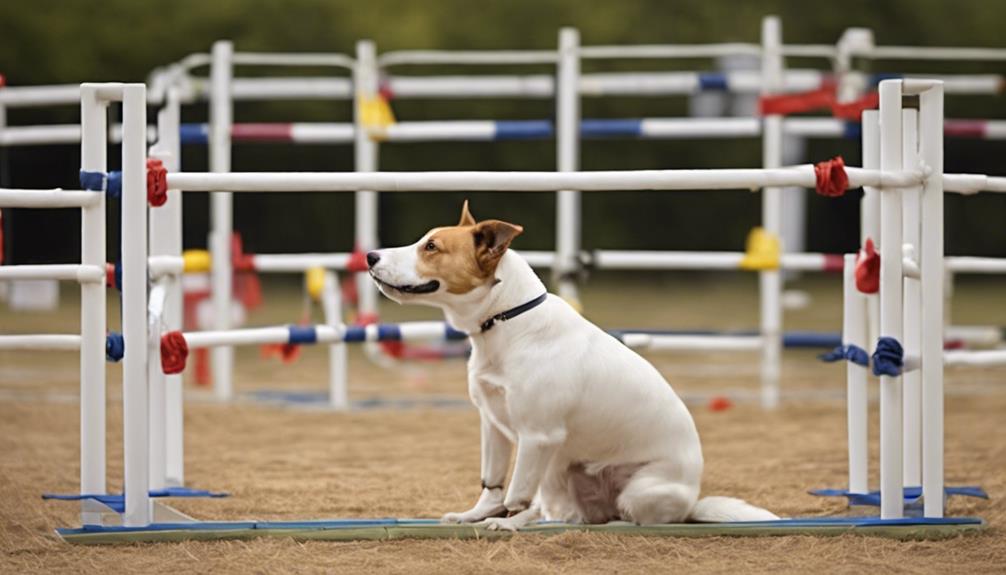
Exploring advanced training techniques for deaf dogs involves tapping into their natural abilities and enhancing their skills through specialized methods such as scent training and touch cues.
Incorporating touch cues in advanced training can help deaf dogs navigate complex tasks with precision and confidence.
Additionally, using visual cues for shaping behaviors like agility or obedience can challenge and stimulate deaf dogs mentally and physically.
Reward-based training is particularly effective in advanced training, as it reinforces positive behaviors and strengthens the bond between the dog and the trainer.
These techniques not only improve the deaf dog's skills but also foster a deeper understanding and communication between the dog and its owner.
Professional trainers experienced in working with deaf dogs can provide tailored advanced training programs that cater to the unique needs and abilities of these special animals.
Frequently Asked Questions
How Do You Train a Deaf Dog?
When training a deaf dog, we rely on visual cues, hand signals, and tactile cues for effective communication. Positive reinforcement, like rewards and treats, is essential for success.
Consistency, patience, and repetition play crucial roles in the training process. Incorporating mark and reward methods, such as clicker training with gestures, can reinforce desired behaviors.
Startle training techniques help desensitize deaf dogs to unexpected touch stimuli and encourage positive reactions.
What Training Tools Are Used for Deaf Dogs?
We utilize various tools in training deaf dogs. These include:
- Vibrating collars for tactile cues
- Flashlights for visual signals
- Hand signals for commands
- Treats/toys for positive reinforcement
Consistent use of specific visual cues is vital for clear communication. These tools help establish a strong training foundation for deaf dogs, enhancing understanding and responsiveness.
Each element plays a crucial role in shaping behaviors and fostering a strong bond between trainer and canine companion.
How Do You Train a Deaf Dog Not to Jump?
When training a deaf dog not to jump, we focus on redirecting their behavior positively. Instead of reinforcing jumping by giving attention, we reward calm actions like sitting.
Visual cues can also be helpful, like stepping back when the dog jumps. Teaching a specific cue for grounding all four paws further reinforces the desired behavior.
Consistency and patience are key in helping deaf dogs understand and adopt new behaviors effectively.
How Do You Train a Deaf Dog Not to Pee in the House?
We train our deaf dog not to pee in the house by establishing a consistent routine for potty breaks. We use visual cues to signal bathroom time and closely monitor for signs of needing to go outside. Rewarding with treats or praise for eliminating outside and promptly cleaning up accidents with an enzymatic cleaner are also important techniques.
These methods reinforce desired behavior and help prevent accidents indoors. Consistency and positive reinforcement are key in house training a deaf dog.
Conclusion
In conclusion, utilizing effective deaf dog trainer techniques, such as visual communication and positive reinforcement, can greatly enhance the training process for deaf dogs.
By establishing trust, using hand signals, and addressing specific behaviors like separation anxiety and leash manners, we can create a strong bond with our canine companions.
With patience and consistency, we can unlock the potential of deaf dogs and help them thrive in their training journey.
Training deaf dogs is like painting a masterpiece with our hands, creating a beautiful and harmonious connection.
Jamie is one of the creative forces behind the words that resonate with our audience at Deaf Vibes. With a passion for storytelling and advocacy, Jamie delves into topics that matter deeply to the deaf and hard-of-hearing community. Jamie’s articles are crafted with empathy, insight, and a commitment to positive change, from exploring the latest advancements in hearing technologies to shedding light on the everyday challenges and victories of those within the community. Jamie believes in the power of shared stories to inspire action, foster understanding, and create a more inclusive world for everyone.
Living with Hearing Loss
How Kirkland Makes Hearing Aids: A Guide
Yearning to discover the secrets behind Kirkland's exceptional hearing aids?

As we explore the intricate process of how Kirkland makes hearing aids, it's fascinating to witness the blend of technology and craftsmanship that goes into creating these devices.
From the initial design stages to the final quality assurance checks, every step in the production journey contributes to the exceptional performance and comfort of the Kirkland Signature 10.0t model.
But what really sets these hearing aids apart? Stay tuned to uncover the secrets behind the precision manufacturing processes and advanced technology that make Kirkland hearing aids a top choice for users seeking optimal hearing solutions.
Key Takeaways
- Collaborate with Sonova for prototype design, focusing on functionality and user experience.
- Choose premium materials and quality components for durability and optimal performance.
- Utilize precision manufacturing and automation for consistent quality and efficiency.
- Prioritize customization, user experience, and support for tailored hearing aid solutions.
Designing the Hearing Aid Prototype
Collaborating with Sonova, we meticulously design and develop the prototype for Kirkland's hearing aids, ensuring they undergo rigorous testing for performance, comfort, and durability. When creating the prototype, various design elements such as size, shape, and color are carefully considered to meet the diverse needs of our customers. We also integrate advanced technologies like Bluetooth connectivity and tap control into the prototype to enhance the overall user experience.
During the design phase, our team focuses on not only the functionality of the hearing aids but also on the aesthetic appeal and ergonomic design. By incorporating feedback from focus groups and experts, we can refine the prototype further before moving into mass production. This iterative process allows us to fine-tune every aspect of the hearing aid, ensuring that it meets the highest standards of quality and performance. At Kirkland, we're dedicated to creating hearing aids that not only improve the quality of life for our customers but also exceed their expectations in terms of design and functionality.
Selecting High-Quality Materials

Selecting premium-grade materials is a crucial step in ensuring the durability and comfort of Kirkland's hearing aids. When it comes to combating hearing loss, the quality of the components used in our devices plays a significant role in delivering optimal performance.
Kirkland meticulously chooses high-quality plastics and metals, akin to selecting prime real estate, to construct durable and comfortable hearing aids that users can rely on. Moreover, sourcing top-notch microphones and speakers is paramount in guaranteeing clear sound reception and transmission, enhancing the overall auditory experience for our customers.
Precision Manufacturing Processes
At Kirkland, our precision manufacturing processes utilize state-of-the-art automated assembly systems to ensure consistent quality and efficiency. These systems allow us to meticulously craft each component of our hearing aids with precision and accuracy.
Our stringent quality control measures are integrated at every step to guarantee that each device meets our high standards for durability and performance.
Automated Assembly Systems
Utilizing advanced automated assembly systems, Kirkland ensures precision in manufacturing their hearing aids to maintain consistent quality standards. These systems are a good thing for us as they allow for intricate details to be accurately put together, ensuring that wearers can hear the sound with clarity.
By incorporating robotics and specialized machinery, Kirkland can reduce the margin of error, leading to higher efficiency during production. The automated assembly process streamlines manufacturing, enabling tight tolerances to be achieved in assembling the hearing aid components.
This level of accuracy in production is crucial for the optimal performance of the hearing aids, ensuring that each device meets the high-quality standards expected by Kirkland's customers.
Quality Control Measures
In maintaining our commitment to excellence in manufacturing, Kirkland upholds stringent quality control measures throughout the production process to ensure the precision and reliability of each hearing aid.
Our rigorous checks at every stage, coupled with advanced technologies and specialized equipment, guarantee consistent quality standards. Each component undergoes meticulous crafting and testing to meet strict specifications and performance requirements.
Thorough inspections, calibration tests, and adherence to industry regulations are integral parts of our quality control measures, ensuring optimal functionality. Kirkland's dedication to precision manufacturing processes results in hearing aids that aren't only reliable and durable but also provide exceptional sound quality and performance, meeting the highest standards of our customers' expectations.
Incorporating Advanced Technology

We integrate cutting-edge technology, such as Bluetooth Classic and tap control, into Kirkland hearing aids to enhance user experience.
Motion sensors are utilized to improve interaction and functionality, while integrated Roger receivers help in background noise reduction for clearer speech.
Our aids also support Bluetooth streaming, allowing for hands-free calls and wireless audio connectivity.
Cutting-Edge Tech Integration
Our approach to incorporating cutting-edge technology in Kirkland Signature hearing aids sets a new standard in enhancing user experience and adaptability. By integrating features like Bluetooth connectivity, users can seamlessly pair their devices with our aids for a more connected experience.
The inclusion of motion sensors further enhances adaptability, adjusting settings based on movement for optimal performance. Additionally, the integration of Roger receivers improves speech understanding in noisy environments, ensuring clear communication in various situations.
Our use of telecoil technology enables better hearing in venues equipped with loop systems, providing amplified sound directly to the aids. Moreover, the EasyLine Remote App empowers users to personalize settings easily, offering a tailored hearing solution at their fingertips.
Innovation in Production
Utilizing cutting-edge techniques such as 3D printing and laser cutting, Kirkland incorporates advanced technology in the production of their hearing aids to ensure precision and innovation.
The incorporation of AI algorithms guarantees precise customization and fitting for each user, while automated assembly lines streamline manufacturing for efficiency.
Quality control measures, including rigorous testing and inspection, ensure the reliability and performance of each hearing aid.
Continuous research and development efforts further drive innovation in Kirkland's production processes, allowing them to meet the evolving needs of consumers efficiently.
Assembling the Internal Components
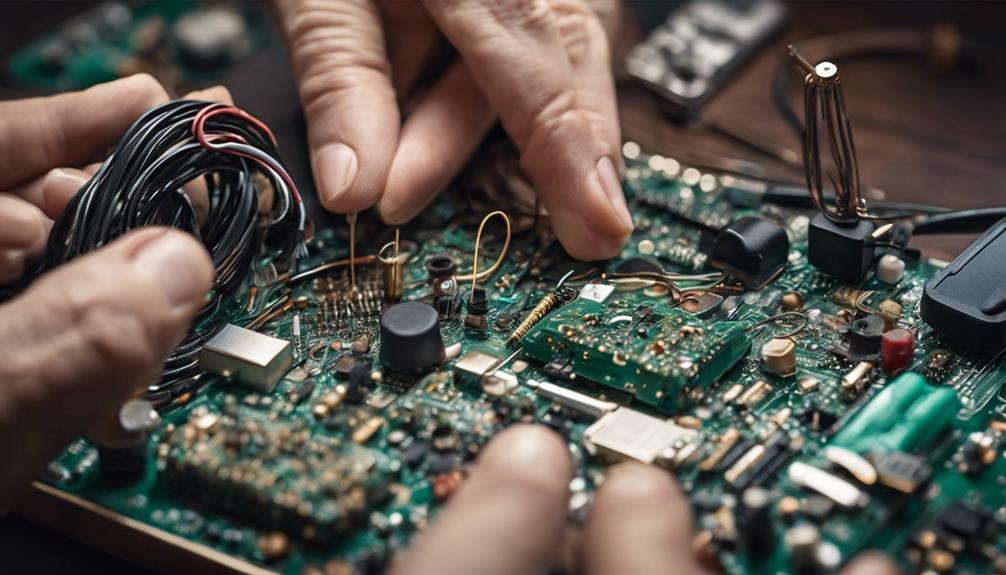
When assembling the internal components of Kirkland hearing aids, skilled technicians meticulously place the microphones, processors, and speakers into the housing with precision. Each component is carefully positioned to ensure seamless integration and optimal functionality. The microphones, responsible for capturing sounds, are strategically located to capture a wide range of frequencies effectively.
Processors, the brains of the hearing aid, are intricately placed to process and enhance the incoming sound signals. Speakers, crucial for delivering amplified sounds to the wearer, are delicately installed to provide clear and natural sound quality.
Precision is paramount during this process to guarantee that all components work harmoniously together, amplifying sounds and ultimately improving the wearer's hearing experience. By sourcing high-quality internal components from trusted manufacturers and utilizing the expertise of skilled technicians, Kirkland ensures that each hearing aid meets rigorous standards for performance and durability. This meticulous assembly process sets the foundation for the functionality and quality of the final product.
Testing for Functionality and Quality
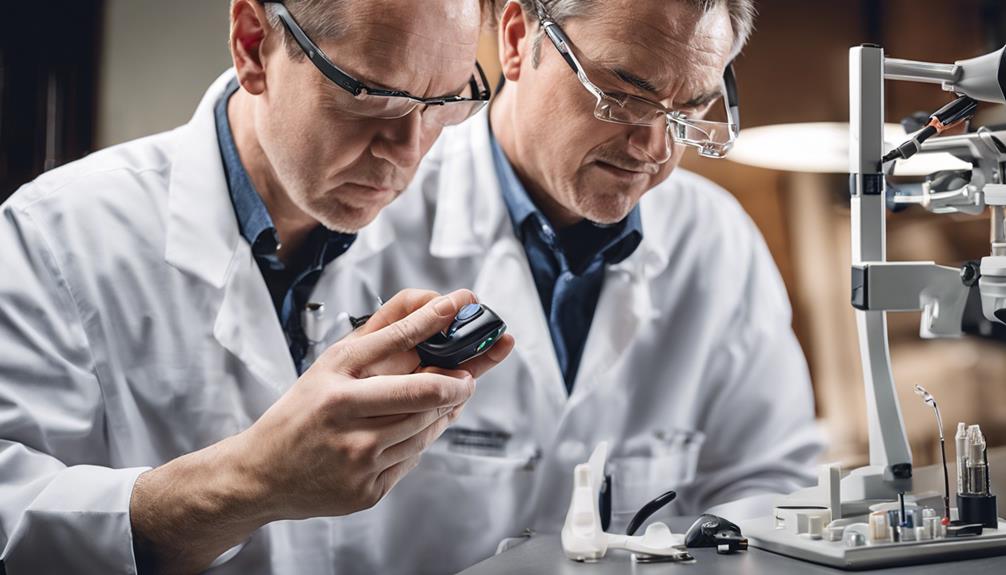
Conducting meticulous and comprehensive functional tests is a critical step in ensuring the quality and reliability of Kirkland hearing aids. Our dedication to delivering top-notch products is evident in the rigorous testing procedures each device undergoes. Here's how we ensure that every Kirkland hearing aid meets our high standards:
- Sound Clarity Testing:
Each hearing aid is meticulously tested to guarantee optimal sound clarity across different frequencies.
- Volume Adjustments:
We check and recheck the volume adjustments to ensure smooth transitions and accurate levels.
- Program Changes:
Testing includes verifying the effectiveness of different programs and the seamless transition between them.
- Connectivity Features:
The functionality of connectivity features such as Bluetooth and wireless capabilities is thoroughly tested to provide a seamless user experience.
Fine-Tuning Sound Performance
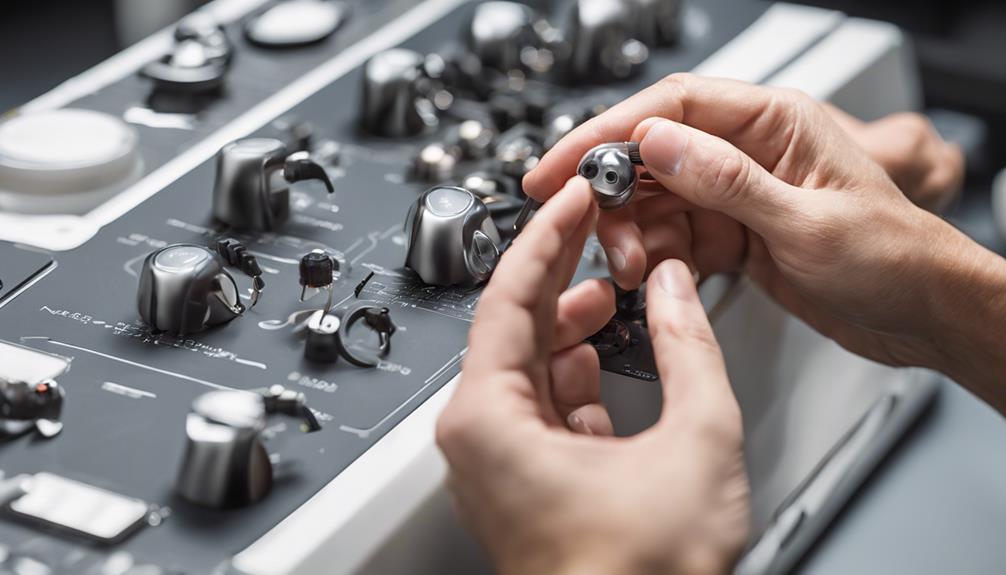
To ensure optimal sound performance tailored to individual needs, Kirkland meticulously fine-tunes the frequency response of each hearing aid. This process involves adjusting the frequency response to match the specific hearing requirements of the wearer. By customizing the sound profile, Kirkland ensures that users receive the best possible listening experience. Additionally, speech enhancement settings can be personalized to improve clarity during conversations in noisy environments. Compression settings are also fine-tuned to enhance comfort and speech understanding. Furthermore, feedback management systems are employed to eliminate whistling and enhance overall sound quality. Real ear measurements play a crucial role in this fine-tuning process, ensuring that the hearing aids provide accurate amplification tailored to the user's unique ear shape and size.
| Fine-Tuning Sound Performance | |
|---|---|
| Adjusting Frequency Response | Customizing Sound Profile |
| Personalizing Speech Settings | Enhancing Comfort and Clarity |
| Utilizing Feedback Management | Ensuring Accurate Amplification |
Customizing for Individual Needs
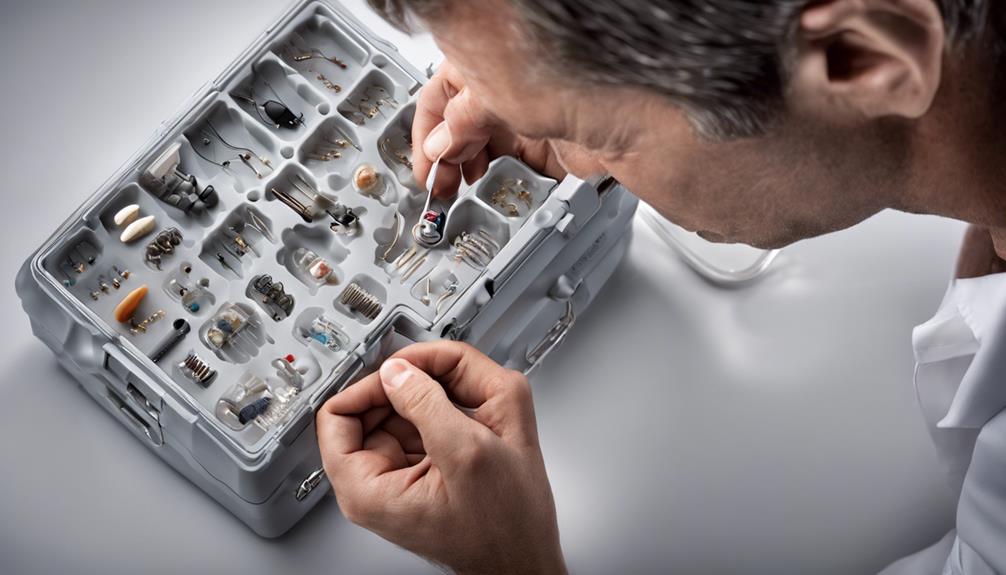
In our meticulous process of customizing hearing aids for individual needs, Kirkland carefully adjusts settings such as volume, noise reduction, and speech enhancement to meet specific hearing requirements. Here's how we tailor each hearing aid to suit the unique needs of our customers:
- Personalized Fitting Options: We offer customized fitting options to enhance comfort and sound quality based on individual ear anatomy and preferences.
- Fine-Tuning Frequency Response: Our experts fine-tune the frequency response to address distinct hearing loss patterns, ultimately improving speech clarity for users.
- Real-Ear Measurement: Kirkland's professional audiologists utilize real-ear measurement techniques to ensure precise customization for each individual, guaranteeing optimal performance.
- Enhanced User Satisfaction: Individual customization not only improves speech understanding but also boosts overall hearing aid performance, leading to heightened user satisfaction.
Through these personalized adjustments, we strive to provide our customers with hearing aids that cater specifically to their unique hearing needs, enhancing their overall auditory experience.
Packaging and Quality Assurance

During our meticulous process of preparing Kirkland hearing aids for distribution, we focus on packaging and quality assurance to ensure the highest standards of functionality and user satisfaction. Each Kirkland hearing aid undergoes rigorous quality assurance testing to guarantee optimal performance. Our dedicated team meticulously inspects every device to ensure it meets our stringent functionality and performance standards before being carefully packaged.
The packaging includes protective cases, charging accessories, and user manuals to provide convenience and ease of use for our customers. Quality control measures are implemented at every stage to ensure that only fully functional hearing aids reach the end-user, reflecting our commitment to delivering top-notch products. The packaging design is user-friendly, featuring clear instructions for setup and maintenance, enhancing the overall user experience.
At Kirkland, we prioritize quality assurance and packaging to uphold our reputation for excellence in providing reliable hearing solutions.
Distribution and Customer Support
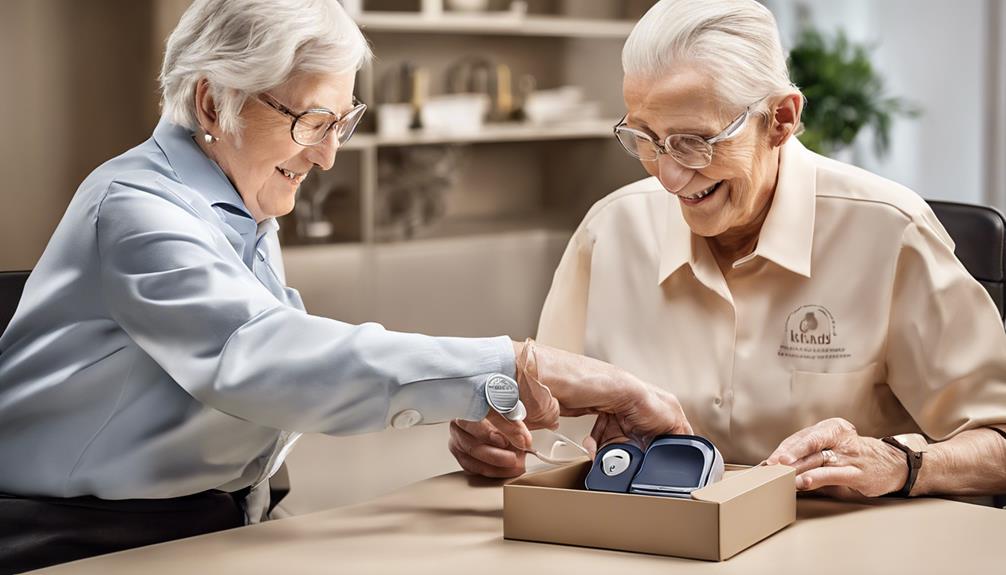
At Kirkland, we prioritize providing excellent customer support through our widespread service centers, ensuring accessibility for those seeking assistance with their hearing aids.
Our warranty coverage details offer peace of mind to customers, guaranteeing quality and reliability in our products.
Additionally, online support options further enhance the customer experience, offering convenience and quick solutions for any inquiries or issues that may arise.
Service Centers Availability
Within select Costco warehouses across the United States, customers can access Kirkland hearing aids exclusively at Costco Hearing Aid Centers, which provide a range of professional services and customer support for users.
- Professional Services: Costco Hearing Aid Centers offer comprehensive services including hearing tests, fittings, adjustments, and follow-up care.
- Dedicated Support Team: Customers have access to a team of audiologists and hearing aid specialists for assistance with questions, troubleshooting, and maintenance.
- Transparent Pricing: Costco's pricing model ensures cost-effective options compared to traditional retailers.
- Convenient Availability: With extended hours and flexible appointment scheduling, Costco Hearing Aid Centers cater to customers' busy schedules.
Costco's commitment to quality service and support ensures a seamless experience for Kirkland hearing aid users.
Warranty Coverage Details
We ensure comprehensive warranty coverage details for distribution and customer support of Kirkland hearing aids from Costco. Our hearing aids typically come with a 3-year warranty that covers repairs and services provided by Costco's hearing aid centers. This warranty ensures that customers can access necessary services at any Costco warehouse offering hearing aid support.
By guaranteeing reliable distribution and customer support, we aim to enhance user satisfaction and demonstrate our commitment to quality. The warranty coverage details for Kirkland hearing aids highlight Costco's dedication to providing excellent support for our valued customers.
Rest assured, we stand by our products and are here to assist with any issues that may arise during the warranty period.
Online Support Options
To enhance the customer experience and provide comprehensive support, our online resources for Kirkland hearing aids at Costco offer a range of helpful tools and information.
- User manuals and guides for setup and troubleshooting are readily available.
- Instructional videos walk you through maintenance and care procedures.
- Prompt assistance is provided through phone, email, and live chat by Costco's support team.
- Enjoy the peace of mind with Costco's reliable return policy and warranty coverage for Kirkland Signature hearing aids.
These online resources, combined with community forums for sharing experiences and recommendations, create a supportive environment for Kirkland hearing aid users seeking guidance and assistance.
Frequently Asked Questions
Why Did Costco Stop Selling Kirkland Hearing Aids?
We stopped selling Kirkland hearing aids due to a shift in our product focus and the end of our partnership with Sonova. This decision allowed us to concentrate on other hearing aid brands.
Rest assured, we continue to support customers who've purchased Kirkland hearing aids and offer a range of quality alternatives. Our commitment remains providing excellent service and solutions for all your hearing needs.
Who Manufactures Costco Kirkland Hearing Aids?
We manufacture Costco Kirkland Signature hearing aids in collaboration with Sonova, a global leader in cutting-edge hearing care solutions. The partnership ensures Costco members receive high-quality, cost-effective hearing aids like the Kirkland Signature 10.0t model.
Sonova's advanced manufacturing facilities adhere to strict quality standards, guaranteeing reliable and efficient products. This collaboration allows for the integration of innovative features, enhancing the overall user experience with our Kirkland Signature line.
Why Are Costco Hearing Aids so Cheap?
Costco's hearing aids are affordable because of their direct-to-consumer approach, cutting out middlemen and reducing costs. By working with top manufacturers like Sonova and leveraging Costco's buying power, we negotiate better prices and pass on those savings to our customers.
Our membership-based model and lack of commissioned sales staff also contribute to keeping prices lower. This allows us to make quality hearing aids accessible to a wider range of customers.
Who Makes the Best Hearing Aids in the United States?
We believe that the best hearing aids in the United States are those that combine advanced technology, comfort, and affordability. Brands like Sonova, which manufactures Kirkland Signature hearing aids for Costco, are known for their high-quality products and innovative features.
Conclusion
In conclusion, the intricate process of how Kirkland makes hearing aids is truly a blend of art and science.
From designing the prototype to fine-tuning sound performance, each step is carefully executed to ensure top-notch quality.
With advanced technology and high-quality materials, these aids are customized for individual needs, providing a seamless listening experience.
Remember, when it comes to hearing aids, Kirkland goes the extra mile to ensure you hear crystal clear.
Jamie is one of the creative forces behind the words that resonate with our audience at Deaf Vibes. With a passion for storytelling and advocacy, Jamie delves into topics that matter deeply to the deaf and hard-of-hearing community. Jamie’s articles are crafted with empathy, insight, and a commitment to positive change, from exploring the latest advancements in hearing technologies to shedding light on the everyday challenges and victories of those within the community. Jamie believes in the power of shared stories to inspire action, foster understanding, and create a more inclusive world for everyone.
Living with Hearing Loss
What Makes Speaking in Front of a Deaf Person Without Sign Language Rude?
Hesitate to speak in front of a deaf person without sign language to uncover the hidden rudeness behind this seemingly innocent act.

Have you thought about how your spoken words affect someone who is unable to hear them? Picture being in a space surrounded by conversations that mean nothing to you because you cannot hear them.
Speaking in front of a deaf person without sign language may seem harmless, but it can unknowingly create barriers to genuine communication and connection. By understanding the importance of accessible communication for the deaf community, we can foster inclusivity and respect in our interactions.
But what are the underlying reasons that make this seemingly innocent act potentially rude?
Key Takeaways
- Ignoring sign language excludes Deaf individuals from communication.
- Disregarding preferred communication disregards cultural sensitivity.
- Lack of sign language can make Deaf individuals feel isolated.
- Respecting sign language fosters inclusivity and respect.
Lack of Understanding Deaf Communication Needs
When speaking in front of a deaf person without sign language, we often overlook the crucial need for visual communication in understanding their language. Deaf individuals rely on visual cues, such as hand signs and gestures, to communicate effectively.
Not using sign language in the presence of a deaf person can be considered rude and dismissive of their preferred way of communication. Deaf individuals aren't 'Deaf and Dumb'; they simply use a different language – sign language. It's essential to recognize the importance of sign language in facilitating communication with the Deaf community.
Speaking without considering the need for visual communication can make it hard for Deaf individuals to follow the conversation, leading to feelings of isolation and exclusion. Understanding and incorporating sign language into our interactions with Deaf individuals isn't only respectful but also inclusive and necessary for effective communication.
Let's strive to be more mindful of the Deaf person's hands and the significance of sign language in their lives.
Disregarding Deaf Person's Preferred Communication

Disregarding a deaf person's preferred mode of communication not only hinders their understanding and participation but also demonstrates a lack of respect for their unique language and identity. When deaf people use sign language, it's crucial to recognize and honor this choice for effective interaction. Here are some reasons why respecting their preferred mode of communication is essential:
- Sign language is their primary means of communication: Deaf individuals rely on visual communication through sign language to express themselves effectively.
- Using verbal communication exclusively can be rude: Disregarding sign language in front of a deaf person can create barriers to understanding and hinder their active participation in conversations.
- Respecting their communication preferences fosters inclusivity: By honoring their choice of communication, we show respect for their identity and language.
- Avoiding sign language can make deaf individuals feel excluded: Failure to respect their preferred mode of communication can lead to feelings of isolation and exclusion.
Ignoring Deaf Culture and Etiquette
When we disregard visual cues and fail to respect the communication preferences of deaf individuals, we risk alienating them from the conversation.
It's crucial to recognize that ignoring Deaf culture and etiquette can lead to feelings of exclusion and disrespect.
Let's remember the importance of inclusivity and understanding in our interactions with the deaf community.
Disregarding Visual Cues
Neglecting visual cues when communicating with a deaf individual not only hinders understanding but also disrespects their cultural norms and preferred mode of interaction. Here are four reasons why disregarding visual cues is detrimental:
- Lack of Connection: Ignoring visual cues disconnects us from the rich tapestry of nonverbal information crucial for effective communication.
- Disrespect: Disregarding visual cues shows a lack of respect for the deaf person's cultural identity and preferred mode of interaction.
- Barriers to Understanding: Missing out on visual cues creates barriers to effective communication, hindering mutual understanding.
- Cultural Insensitivity: Failing to acknowledge visual cues can be perceived as dismissive of the deaf person's language and cultural heritage.
Lack of Respect
Addressing a deaf person without considering sign language preferences disregards their cultural identity and communication needs, demonstrating a lack of respect and understanding. It is crucial to honor their preferred mode of communication to show inclusivity and respect for their cultural background. By neglecting to utilize sign language, miscommunication can occur, leading to the deaf individual feeling marginalized and excluded. Deaf etiquette emphasizes the importance of inclusive communication methods, highlighting the significance of accommodating the needs of the deaf community. Engaging in verbal communication without regard for sign language not only showcases a lack of respect but also hinders effective and respectful interaction. Prioritizing inclusive communication is essential to fostering understanding and respect for individuals with different communication needs.
| Lack of Respect | Preferred Mode of Communication |
|---|---|
| Disregards cultural identity | Honors communication needs |
| Neglects deaf etiquette | Values inclusive communication |
| Leads to miscommunication | Prevents frustration |
Failing to Ensure Effective Communication

Unfortunately, overlooking the importance of using sign language when speaking in front of a deaf person can result in communication breakdowns and feelings of exclusion. Deaf individuals rely on visual communication, so not accommodating their needs can be disrespectful and frustrating.
Here are four reasons why failing to ensure effective communication with sign language is detrimental:
- Deaf individuals may feel isolated and left out of the conversation, impacting their sense of belonging.
- Misunderstandings can arise, leading to confusion and hindering the exchange of ideas.
- Without sign language, deaf individuals may struggle to express themselves fully, limiting their participation.
- Effective communication with sign language is essential for showing respect and consideration towards the deaf community, fostering inclusivity and understanding.
Sign Language as a Form of Respect

Sign language serves as a fundamental expression of respect towards deaf individuals, embodying inclusivity and understanding in communication. When we use sign language when interacting with a deaf person, we're showing that we value their communication needs and preferences. By not accommodating their preferred mode of communication, we inadvertently create a barrier to understanding and participation for the deaf individual. It's essential to recognize that spoken language alone can exclude deaf individuals from conversations, making them feel isolated and left out.
Using sign language demonstrates our respect for the language and culture of the deaf community. It shows that we're willing to make an effort to communicate in a way that's most effective and comfortable for them. By embracing sign language, we not only break down communication barriers but also foster a more inclusive and respectful environment for all individuals, regardless of their hearing abilities.
Impact of Inaccessible Communication on Deaf Individuals

When communication isn't accessible to deaf individuals, it creates barriers that prevent them from fully engaging and participating.
This lack of accessibility can lead to feelings of isolation and exclusion in social situations.
Providing accessible communication methods is crucial to ensure deaf individuals feel respected and included.
Communication Barriers for Deaf
Communication barriers for deaf individuals impact their daily interactions, leading to feelings of isolation and exclusion.
- Deaf person without sign language: Being excluded from conversations hinders their participation.
- Visual communication: Lack of sign language leads to misunderstandings and frustrations.
- Feeling of isolation: Not using sign language disregards their preferred mode of communication.
- Impact on effective communication: Essential information may be missed, affecting comprehension.
Understanding and addressing these communication barriers is crucial in fostering inclusivity and ensuring that deaf individuals can fully participate in interactions. By acknowledging their preferred mode of communication and actively working to include them, we can create a more accessible and supportive environment for all individuals, regardless of their hearing abilities.
Importance of Accessibility
Understanding the challenges faced by deaf individuals due to inaccessible communication highlights the critical need for prioritizing accessibility in all interactions.
Inaccessible communication not only excludes deaf individuals from active participation but also contributes to feelings of isolation and frustration.
Sign language plays a crucial role in breaking down these barriers and fostering inclusion.
By providing accessible communication methods, we can ensure that deaf individuals have equal opportunities to engage in discussions and access information.
Without such accommodations, deaf individuals may face obstacles in social interactions and overall engagement.
Prioritizing accessibility in communication is essential for creating a more inclusive environment where all individuals, including those who are deaf, can participate fully and feel valued.
Importance of Cultural Sensitivity and Inclusivity

In order to foster a truly inclusive environment, it's essential to prioritize cultural sensitivity when interacting with individuals from diverse backgrounds, including the deaf community.
Here are four key reasons why cultural sensitivity and inclusivity are crucial when communicating with deaf individuals:
- Respecting Preferred Mode of Communication: By using sign language, we honor the deaf person's choice of communication, showing respect for their cultural identity.
- Fostering Effective Communication: Embracing sign language promotes understanding and effective communication between hearing and deaf individuals, bridging potential communication gaps.
- Promoting Inclusivity: Using sign language in interactions with deaf individuals creates an inclusive environment where everyone feels valued and included.
- Demonstrating Mutual Respect: Prioritizing cultural sensitivity showcases mutual respect, acknowledging the richness of diversity and different communication needs within the deaf community.
Frequently Asked Questions
Why Is It Considered Rude to Speak in Front of Deaf People?
When we speak in front of deaf individuals without sign language, it can be seen as rude because it excludes them from understanding and participating in the conversation. This exclusion can make them feel isolated and disrespected, leading to frustration and misunderstandings.
Ignoring their preferred mode of communication hinders their ability to engage fully. It's important to be mindful of these factors to ensure inclusive and respectful communication.
What Are 2 Things Considered Rude by Deaf People?
When considering rudeness towards deaf individuals, two elements stand out: exclusion and ignorance. Excluding deaf people from conversations by not providing accessible communication methods like sign language can isolate them.
Ignorance of their preferred mode of communication overlooks their needs and can be disrespectful. Understanding and embracing accessible communication methods is crucial to showing consideration and inclusivity towards deaf individuals.
Which of the Following Is Considered Rude to Deaf People?
When speaking with a deaf person, it's crucial to consider their communication preferences. Not using sign language in this situation can be seen as disrespectful and exclusionary.
It's important to show respect by utilizing sign language, which allows for better understanding and inclusivity. By incorporating sign language into our interactions, we demonstrate consideration for the deaf person's needs and promote a more inclusive environment for everyone involved.
How Do Deaf People Talk to People Who Don T Know Sign Language?
When deaf individuals communicate with people who don't know sign language, they may use written messages, gestures, facial expressions, or speechreading. Some may seek help from family, friends, or interpreters. Technology like text messaging or communication apps can also aid in communication.
Additionally, carrying communication cards or using communication notebooks is common. Training programs and resources exist to teach basic sign language or communication strategies to improve interactions with deaf individuals.
Conclusion
In conclusion, speaking in front of a deaf person without considering their communication needs is like trying to navigate a dark room without a flashlight.
It's important to be mindful of how we communicate with others, especially those who may require different methods to fully engage in conversation.
By respecting and accommodating the needs of deaf individuals, we can create a more inclusive and understanding environment for everyone involved.
Let's strive to communicate effectively and thoughtfully with all.
Jamie is one of the creative forces behind the words that resonate with our audience at Deaf Vibes. With a passion for storytelling and advocacy, Jamie delves into topics that matter deeply to the deaf and hard-of-hearing community. Jamie’s articles are crafted with empathy, insight, and a commitment to positive change, from exploring the latest advancements in hearing technologies to shedding light on the everyday challenges and victories of those within the community. Jamie believes in the power of shared stories to inspire action, foster understanding, and create a more inclusive world for everyone.
Understanding Hearing Loss
How Windows High Volume Can Cause Hearing Loss: Tips to Protect Your Ears
Wander into the world of windows high volume and learn how it silently impacts your hearing health – the secrets to safeguarding your ears await!

Let’s be honest, the allure of blasting music through the windows is undeniable, but have you ever thought about the potential effects on our auditory health?
As we navigate through our daily lives, the constant exposure to loud noises can quietly take a toll on our ears without us even realizing it.
Understanding how this seemingly harmless habit can lead to potential hearing loss is crucial.
Stay tuned as we unravel the secrets of protecting our ears and discover practical tips to safeguard our auditory well-being in a world filled with noise.
Key Takeaways
- High volume from windows can damage hearing by harming delicate ear cells.
- Protect ears with earplugs or breaks to prevent irreversible auditory damage.
- Regular check-ups detect and prevent worsening hearing loss from high volumes.
- Be mindful of noise levels to avoid immediate and long-term hearing issues.
Understanding the Impact of High Volume
Exposure to high volume sounds can have detrimental effects on our hearing health, causing damage to the delicate hair cells in the ear and potentially leading to permanent hearing loss. Volume can cause Hearing.
The impact of high volume on hearing is profound and often underestimated. Prolonged exposure to loud noise, whether from music, machinery, or other sources, can result in irreversible damage to the auditory system. This damage primarily affects the hair cells in the cochlea, which are responsible for translating sound vibrations into electrical signals that the brain can interpret. When these hair cells are subjected to high volumes, they can become overworked and eventually die off, leading to hearing loss.
Additionally, exposure to loud noise can also trigger the development of tinnitus, a condition characterized by persistent ringing or buzzing in the ears. It's crucial to understand that even short bursts of high volume sounds, such as explosions or gunshots, can cause immediate and severe damage to our hearing.
Therefore, taking proactive measures to protect our ears from excessive noise exposure is essential for preserving our hearing health in the long term.
Common Symptoms of Hearing Damage

Indications of hearing damage commonly include persistent ringing in the ears, difficulty in understanding speech clearly, and a sense of sounds being muffled. Individuals with hearing damage may also exhibit sensitivity to loud noises and find it challenging to follow conversations in noisy environments. As part of ear protection, recognizing these symptoms early is crucial to prevent further damage and maintain overall hearing health. Below is a table summarizing common symptoms of hearing damage:
| Symptom | Description |
|---|---|
| Ringing in the ears (tinnitus) | Persistent noise or ringing sensation in one or both ears. |
| Difficulty understanding speech | Struggle to comprehend conversations, especially in noisy or crowded settings. |
| Muffled sounds | Sensation of sounds being unclear, dulled, or lacking sharpness. |
Being attentive to these signs and seeking professional evaluation promptly can aid in the management and prevention of hearing loss. Remember, early intervention plays a key role in protecting your ears and preserving your hearing abilities.
Risks of Prolonged Exposure
Continuously exposing oneself to high volume levels poses a significant risk to the delicate hair cells in the inner ear, potentially leading to irreversible damage and long-term hearing issues. High volume can cause various detrimental effects on hearing health, including:
- Development of Tinnitus: Prolonged exposure to high volume levels can result in the development of tinnitus, a condition characterized by a persistent ringing, buzzing, or hissing sound in the ears. This debilitating condition can significantly impact quality of life and may be challenging to manage.
- Noise-Induced Hearing Loss: High volume exposure is a common cause of noise-induced hearing loss, particularly in industries with high noise levels. This type of hearing loss is often gradual but can lead to permanent damage if preventive measures aren't taken.
- Immediate Auditory Damage: Even brief exposures to loud noise can cause immediate damage to the auditory system. This underscores the importance of protecting your ears from high volume levels to prevent both short-term and long-term consequences.
Effective Ways to Protect Your Ears

To safeguard our hearing health, implementing effective strategies to protect our ears is paramount in preventing potential damage from high volume exposure. Wearing earplugs or earmuffs in noisy environments significantly reduces the risk of hearing loss by acting as a barrier against loud sounds.
Taking regular breaks from prolonged exposure to loud noises allows your ears to recover and lowers the chances of overexposure. It's crucial to maintain safe volume levels when using headphones to prevent hearing damage. Opting for noise-canceling headphones can help reduce external noise, allowing you to listen at lower volumes without compromising sound quality.
Additionally, being mindful of noise levels in recreational activities like concerts can safeguard your ears from potential harm. By incorporating these practices into our daily routines, we can proactively protect our hearing and reduce the risk of hearing loss associated with high volume environments.
Importance of Regular Hearing Check-Ups
Regular monitoring of one's hearing health through routine check-ups is crucial for early detection and prevention of potential hearing loss. Here are three key reasons why regular hearing check-ups are essential:
- Early Detection: Regular check-ups can help identify early signs of hearing loss that may otherwise go unnoticed. Detecting hearing impairment in its initial stages allows for timely intervention and management strategies to be implemented.
- Assessment of Hearing Impairment: Hearing screenings conducted during check-ups can assess the extent of any existing hearing impairment. These assessments provide valuable information about the level of hearing loss and guide professionals in developing personalized treatment plans.
- Prevention of Deterioration: Early intervention through regular check-ups can prevent further deterioration of hearing. Monitoring changes in hearing health over time enables healthcare providers to intervene proactively and implement measures to preserve and protect the individual's hearing capabilities. Regular check-ups are, therefore, crucial for maintaining optimal ear health and overall well-being.
Frequently Asked Questions
Can Driving With the Windows Down Damage Your Hearing?
Yes, driving with the windows down can damage our hearing. Noise levels inside a car at highway speeds can exceed safe limits, leading to potential hearing loss over time.
It's essential to be cautious of this risk and take steps to protect our ears from prolonged exposure to loud wind noise while driving. Using ear protection like earplugs or noise-canceling headphones can help mitigate this danger and safeguard our hearing health.
How Do I Turn off Ear Protection in Windows?
Sure thing!
To turn off ear protection in Windows, right-click on the volume icon. Choose 'Sounds' then 'Playback' to find device settings. Double click on the playback device and uncheck the ear protection option. Apply the changes and test volume adjustments.
This simple process can help prevent sudden loud volume spikes that may cause hearing loss. Remember, always prioritize your ear health by taking such precautions.
How Can I Protect My Ears From Hearing Loss?
We can safeguard our hearing by using ear protection in loud environments, taking breaks from loud sounds, and maintaining safe volume levels with headphones.
Noise-canceling headphones can reduce the need for high volumes. Being aware of noise levels in activities like concerts is crucial for hearing health.
Regularly implementing these practices helps prevent damage to delicate ear structures and minimizes the risk of hearing loss.
How Can You Protect Yourself From Excessive Sound?
To protect ourselves from excessive sound, we must be vigilant about our surroundings and exposure to loud noises. Utilizing ear protection like earplugs or earmuffs, taking breaks from noisy environments, and maintaining safe volume levels with headphones are essential strategies. Noise-canceling headphones can also help reduce external noise, minimizing the need for high volumes.
Being mindful in recreational settings, like concerts, can prevent sudden exposure to damaging sound levels.
Conclusion
In conclusion, we must recognize the importance of protecting our ears from high volume to prevent hearing loss. By taking proactive measures such as using earplugs and maintaining safe volume levels, we can safeguard our hearing health.
Regular hearing check-ups are crucial to monitor any potential damage. Let's remember that our ears are delicate and valuable, and by prioritizing their protection, we can enjoy a lifetime of clear and healthy hearing.
Taylor brings a dynamic and analytical perspective to the Deaf Vibes team, focusing on research-driven content that educates and informs. With an unquenchable curiosity for new developments, policies, and social issues affecting the deaf and hard-of-hearing community, Taylor’s writing is a crucial resource for readers seeking to navigate these areas. Whether breaking down legal rights, highlighting educational opportunities, or offering guides on accessible technology, Taylor’s work is an invaluable asset to those seeking to empower themselves and others. Taylor’s commitment to accuracy and depth ensures that our readers have access to reliable and actionable information.
-

 Navigating the VA System1 month ago
Navigating the VA System1 month agoVA Hearing Loss Rating Chart: Understanding Disability Compensation
-

 Therapies and Interventions4 days ago
Therapies and Interventions4 days ago10 Auditory Processing Goals for Effective Speech Therapy
-

 Vetted1 month ago
Vetted1 month ago15 Best Oticon Hearing Aids to Improve Your Hearing in 2024
-

 Sign Language1 day ago
Sign Language1 day agoMastering the Art of Signing Letters in Sign Language
-

 Navigating the VA System4 weeks ago
Navigating the VA System4 weeks agoUnderstanding Bilateral Hearing Loss VA Rating Criteria
-

 Tinnitus1 month ago
Tinnitus1 month agoVA's Rating System for Tinnitus and Hearing Loss Explained
-

 Sign Language7 days ago
Sign Language7 days agoSign Language Emoji Translator: How to Communicate With Gestures
-

 Sign Language2 months ago
Sign Language2 months agoMedical Sign Language PDF: A Comprehensive How-To Guide


















